“Making a wrong decision is understandable. Refusing to search continually for learning is not.” -Phil Crosby
It was a busy week, from science to politics to the simple question of Earth's color here at Starts With A Bang. As always, you didn't disappoint, with plenty to say about it all, and I'm stoked to continue the conversation. Just in case you missed anything:
- How, exactly, did Newton fail? (for Ask Ethan),
- Mockery gets you nowhere (for our Weekend Diversion),
- 50,000 evolving galaxies (for Mostly Mute Monday),
- Why is Earth blue?,
- Dear Ben Carson: an open letter,
- and Logic is no match for science (for Throwback Thursday).
I also had a hopeful piece about human exploration of Mars over at Forbes:
Also, for those of you invested in our Patreon, we just hit the $500/mo. milestone plus passed the 100 donor mark, meaning I'll not only be creating monthly podcasts starting in October, but I was so excited I gave an early reveal of my halloween costume plans to all my Patrons. Now, it's straight into the Comments of the Week!
From Sinisa Lazarek on the first tests of Einstein vs. Newton: "When you mentioned proofs (mercury orbit and deflection of light rays).. in his book Lorentz mentions a 3rd one that was expected at that time.. gravitational redshift. But experiments from that time weren’t able to detect it."
Today, there are four classical tests of general relativity: post-Newtonian contributions to orbits, gravitational lensing and deflection of light, gravitational redshifts and blueshifts, and the Shapiro time delay, which is a sort of gravitational time-dilation. Einstein didn't realize the full impact his theory would have on all orbits; he stuck to Mercury as the sole example, which was a post-diction rather than a prediction. The deflection of light was tested with starlight during an eclipse; the first gravitational lenses were not discovered until the 1970s! The Shapiro time delay was not worked out until 1964 by Irwin Shapiro, yet it, too, is a straightforward classical test. But gravitational redshift and blueshift must exist for a simple reason: conservation of energy.
Imagine you had a particle at rest, falling towards a gravitational source. Obviously, it's going to have more kinetic energy when it's closer to the surface of the gravitational source than when it was far away. We're simply turning potential energy into kinetic energy here. No arguments, right?
Now, instead, imagine you had a particle/antiparticle pair annihilating. One annihilates high up, when they were still at rest, while another annihilates after falling a large distance towards the gravitational source.
One is going to have to be higher in energy, right? By the conservation of energy, this must be true. But if the annihilation was to two photons, what does that mean?
It means that the photons that annihilate lower down in the gravitational well must have a higher energy than the ones that annihilated higher up, by the conservation of energy. But what if the photons had annihilated higher up and then fell down into the well? That order shouldn't matter! They should still be higher in energy deeper in the well. Hence, gravitational redshift when you escape a gravitational source, and gravitational blueshift when you fall into one.
The experiment that finally showed the effect was the Pound-Rebka experiment, which occurred in 1959. By having a source emit a photon of a very particular wavelength, and then have that photon travel upwards against the pull of gravity, it could no longer be absorbed, thanks to the gravitational redshift. But if you drove the source (or the target) at the correct frequency (or velocity), changing the doppler frequency of the photon, you could cause it to be captured. By quantitatively measuring how much the photon's wavelength shifted as a function of altitude, they were able to verify the predictions of Einstein. This same effect is necessary for correct calibration of GPS satellites, and so it's another win for general relativity. A fuller discussion of this and other tests of relativity is contained in chapter 2 of my upcoming book, Beyond The Galaxy. (It's good, I promise!)
Image credit: screenshot from the LA Times at http://www.latimes.com/science/sciencenow/la-sci-sn-science-quiz-americ….
From RD on science literacy and punching down: "I found the statement of your host in reply, “A correct answer is better than having an incorrect answer,” so very sad. An ever increasing understanding of science and about science means much more than reducing scientific knowledge to simplistic statements, with or without (sic) artiface. This is what harms science education in the first place! Students who see science as laden with traps and pretense will never engage with it."
Clearly, the host of the show and I did not see eye-to-eye on that issue at all. Of course it's easy to assume a correct answer is better than an incorrect one, but is that always true? Consider the curious case of Stacy McGaugh, who correctly predicted in 1999 (before WMAP) the amplitude and location of the second acoustic peak in the CMB (blue line) better than the Lambda-CDM prediction (red line) using the best data at the time.
But today, we have data out to the seventh acoustic peak, and Lambda-CDM is right, and the no-CDM model is wrong. Yet he's still talking about it! From the article cited above:
CDM correctly predicted the position of the first peak (the geometry is very nearly flat) but over-predicted the amplitude of both the second and third peak. The most favorable a priori case is shown; other plausible
CDM parameters predicted an even larger second peak. The most important parameter adjustment necessary to obtain an a posteriori fit is an increase in the baryon density
above what had previously been expected from BBN. In contrast, the no-CDM model ansatz made as a proxy for MOND successfully predicted the correct amplitude ratio of the first to second peak with no parameter adjustment.
So the incorrect theory got the correct answer... but for the wrong reason! And it meant that all the other peak predictions it gave were way off. In other words, getting the right answer for the wrong reason can often lead you to more and greater mistakes than getting the wrong answer, which would compel you to go and look for problems. In all cases, there's nothing wrong with being wrong, whether you got the right or wrong answer, used the right or wrong method, or had the right or wrong facts at your disposal.
The only thing wrong is if you don't learn, and aren't open to revising what you think based on the evidence at hand. Here in the USA, we're going to hear a lot about flip-flopping over the coming 14 months or so, but I'd rather have someone change their mind because new evidence came out -- I'd rather have someone learn -- than have it turn out any other way. I hope all of you would, too.
Image credit: NASA, ESA, and M. Davis (University of California, Berkeley), of the Extended Groth Strip, 2004.
From PJ on the real positions of galaxies in the deep abyss of space: "Personally, I would like to compare the real position of these objects to their observed positions to get an idea of their real motion."
This can be done! When we measure galaxies, we're taking their redshifts, assigning them distances based on Hubble's law, and then inferring their 3D positions based on this observation and this calculation. As Sinisa Lazarek points out, we've created some awesome visualizations based on this methodology.
But because we're aware of these effects, we can correct for them.
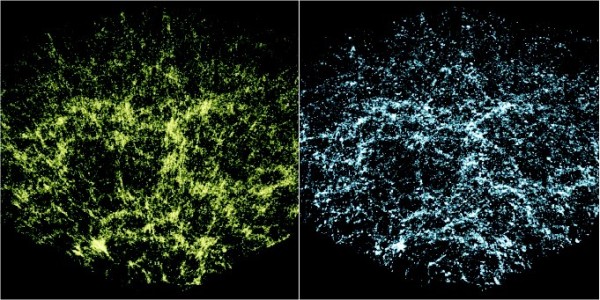 Galaxies shown in redshift space (left) and real space (right). Notice the tremendous differences. Image credit: M.U. SubbaRao et al., New J. Phys. 10 (2008) 125015, via IOPscience.
Galaxies shown in redshift space (left) and real space (right). Notice the tremendous differences. Image credit: M.U. SubbaRao et al., New J. Phys. 10 (2008) 125015, via IOPscience.
So we can construct these "real space" maps -- using what we've learned from simulations -- and we can accurately map out where these galaxies actually are located in 3D space.
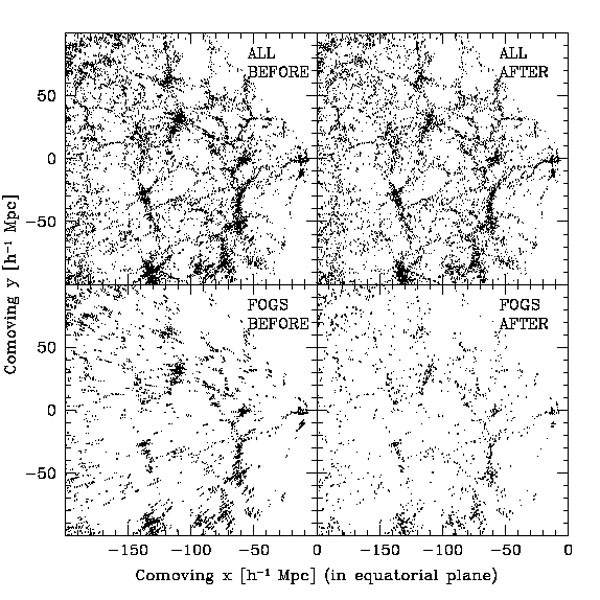 Note how the FOGs (Fingers of God) disappear after we do this processing. Image credit: Tegmark, M., et al. 2004, ApJ, 606, 702.
Note how the FOGs (Fingers of God) disappear after we do this processing. Image credit: Tegmark, M., et al. 2004, ApJ, 606, 702.
That's a pretty impressive change. Sure, it's harder to do the farther an object is from us, and we may make errors for any one individual galaxy (because this is a statistical effect), but this type of analysis brings us a lot closer to the "real" Universe than we'd ever get otherwise.
 Image credit: HD Wallpapers, via http://hdwallpapers-download.com/deep-ocean-image-67.html#.VgH9SGTBzGc.
Image credit: HD Wallpapers, via http://hdwallpapers-download.com/deep-ocean-image-67.html#.VgH9SGTBzGc.
From Simon on why the Earth is blue: "I seem to recall this coming up as a trick question on the TV show QI… asking “why does the ocean appear blue”, the answer was “because it *is* blue”."
And yet, we still paint our in-ground swimming pools to mimic the ocean.
I ran into a great comment on Google+ from David Andrews, who's spent decades diving, and who only made the connection of why the ocean is blue with this article:
Scuba diving since the '80s allows me to tell within 10 feet the depth a picture was taken at due to how blue the surroundings are.
At 80 feet red and yellow are shades of grey - until you shine your dive light on them and the colors explode!
This is something you can see in pictures of the deep ocean.
 Image credit: WiseGEEK / © 2003 - 2015 Conjecture Corporation, via http://www.wisegeek.com/what-are-crustaceans.htm.
Image credit: WiseGEEK / © 2003 - 2015 Conjecture Corporation, via http://www.wisegeek.com/what-are-crustaceans.htm.
Reds disappear first, followed by oranges, yellows, greens, violets, and finally, only after hundreds of meters, blues. The penetration and persistence of blue in the water is why it appears blue. Or, as Simon said, it's because it is blue. Now I've never seen QI, but we don't all have the luxury of living in the UK...
From AJKamper on the entropy of the young Universe: "Is it really accurate to describe the Big Bang as “high-entropy?” It seems to me (following Sean Carroll here) that it has to be very LOW entropy in order for it to go up."
Look, there was a lot to say about Ben Carson's statements and I sure did say a lot. Yes, we can go after anyone for their anti-science positions, whether it be about climate change, GMOs, pollution, fluoride, the Big Bang, evolution, vaccines, or anything else. But my focus here is (and I would like for it to always be) on education, with kindness and compassion, for everyone.
That said, yes, it is accurate to describe the Big Bang as high-entropy, and Sean Carroll knows this and (IMO) has always explained this poorly. Someone also asked about it on my Patreon, so here's my response.
The very, very early Universe (pre-Big Bang, during inflation) had practically ZERO entropy. One of the nice features of cosmic inflation is that when it ends -- via the process of reheating -- it gives us a very high entropy state that emerges from a very low entropy one. So we go from a Universe (inflationary) with almost no entropy at all to a Universe filled with all sorts of hot, energetic particles confined to a very small space. And it's expanding, and cooling, and very, very high in entropy. This was one of the problems inflation serendipitously solved!
Once the Big Bang has taken place, and we have a matter, antimatter and radiation-filled Universe, it's a very high entropy state immediately. The entropy over the next 13.8 billion years has increased by a lot: we've formed stars, planets, galaxies, clusters, humans, etc., and we've done it for a very long time. How much does the entropy of the Universe increase from the hot Big Bang until today? By a factor of 2 or 3. Now, that's large, but not like the factor of ~10^91 that it increased by when inflation ended. I hope this helps clear things up!
And finally, from Malcolm Walker on logic, science, and the importance of experiment: "I think a better illustration of this point occurred in the 16th century in Europe. In general when you stand still and look at a moving object (bird wagon etc) it is moving and you are not, so everyone assumed that because if you stood still and looked at the sun across a day it was moving and you were not. It wasn’t just church doctrine everyone believed it. It was science, the need to understand the movement of the planets by observation and then deduction that proved that the earth revolves not the sun. Logic and gut intuition would still have us believing the sun revolves around the earth. This understanding could not be reached without the scientific method, it could not be reached via logic."
Eppur si muove, right? There are all sorts of examples of why logic will lead you astray, but the key takeaway -- the key thing they all have in common -- is that you must do the experiment. You must put your conclusions, ideas, hypotheses, etc., to the test. You must challenge; you must verify. If you fail to do that, you have not yet reach the level of science, and so you have no claim to say, "this is valid," because you have no way of quantifying something's level of validity.
I do prefer the Poisson/Fresnel/Arago story, because of how blatantly it exposes this point and how rarely this story is told, but there are many good options for illustrating this. Choose your own!
Thanks for a great week, everyone, and can't wait to find out what this next one has in store!

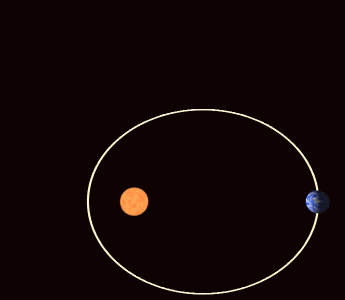

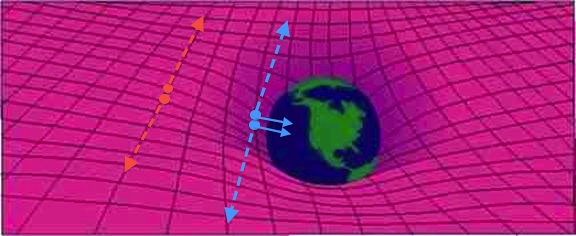
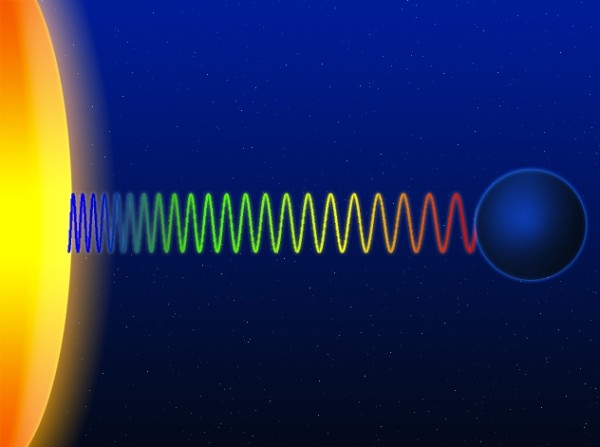
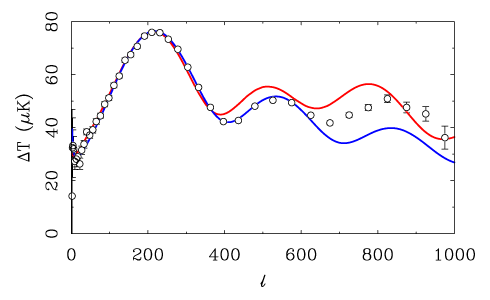

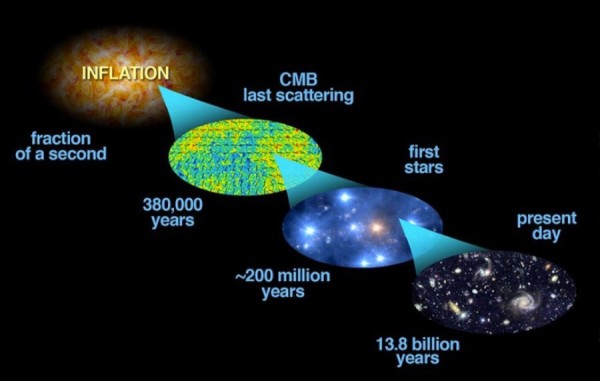

"Eppur si muove, right? There are all sorts of examples of why logic will lead you astray, but the key takeaway — the key thing they all have in common — is that you must do the experiment. You must put your conclusions, ideas, hypotheses, etc., to the test. "
Which people of faith "fathies" do. Hmm Left door open last night and now stuff is gone. conclusion SOMEONE STOLE IT. WHY????
My "Logic" says it's mine, their "Logic" says so what it's mine now.
The bigger social picture of others "Logical" input says No It's NOT yours you Stole It from X and Now you pay back OR go to jail.
Just awesome article. Those who love science must love this post.
Put DOWN the peyote and step AWAY from the keyboard.
Thanks for the mentions in this article. For the record, I don't live in the UK either, but re-runs of the series appear regularly on NZ TV. Alas, mostly just the first six seasons or so... for some reason the newer ones don't come our way either.
*ahegm*